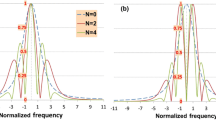Abstract
A series of experiments are carried out by current modulating a tunable diode laser, and slowly ramping the wavelength to scan weak absorption lines in gases at pressures ranging from 2 to 60 Torr. A lock-in amplifier detects the second harmonic (2f) of the modulation frequency, and the experimental 2f signals are compared with theory. Detailed measurements are made on Lorentzian, Voigt, and Gaussian line profiles, over a wide range of modulation amplitudes. Excellent agreement between experiment and calculation is obtained in all cases. This quantitative understanding enables one to derive true lineshapes and linewidths of very weak absorption lines from measurements of 2f lineshapes only. Results are applicable to trace gas detection using tunable diode lasers, and to other areas of spectroscopy and magnetic resonance where harmonic detection techniques are routinely employed to monitor weak signals.
Similar content being viewed by others
References
J.Reid, J.Shewchun, B.K.Garside, E.A.Ballik: Appl. Opt.17, 300–307 (1978)
J.Reid, B.K.Garside, J.Shewchun, M.El-Sherbiny, E.A.Ballik: Appl. Opt.17, 1806–1810 (1978)
J.Reid, M.El-Sherbiny, B.K.Garside, E.A.Ballik: Appl. Opt.19, 3349–3354 (1980)
H.Wahlquist: J. Chem. Phys.35, 1708–1710 (1961)
R.Arndt: J. Appl. Phys.36, 2522–2524 (1965)
G.V.H.Wilson: J. Appl. Phys.34, 3276–3285 (1963)
M.L.Olson, D.L.Grieble, P.R.Griffiths: Appl. Spectrosc.34, 50–56 (1980);34, 56–60 (1980)
E.D.Hinkley, R.T.Ku, P.L.Kelly: InLaser Monitoring of the Atmosphere, ed. by E.D. Hinkley, Topics Appl. Phys.14 (Springer, Berlin, Heidelberg, New York 1976) p. 237
The theory given in Sect. 1 is still a good approximation whenI 0(ν) has a small linear variation with ν [7]
For convenience, we use —H 2(χ,m) to illustrate theory and experiment. This ensures that at line centre the signal is positive
V.N.Faddeyeva, N.M.Terent'ev: In tables of values of the function\(w(z) = \exp ( - z^2 )\left[ {1 + \frac{{2i}}{{\sqrt \pi }}\int\limits_0^z {\exp (t^2 )dt} } \right]\) for complex argument (Pergamon Press, London 1961)
J.Humlicek: J. Quant. Spectrosc. Radiat. Transfer21, 309–313 (1978)
L.S.Rothman, S.A.Clough, R.A.McClatchey, L.G.Young, D.E.Snider, A.Goldman: Appl. Opt.17, 507 (1978)
R.C.Isler: J.Opt. Soc. Am.59, 727–733 (1969)
We convert the modulation voltageA to current modulation by using the manufacturer's specifications. m is converted to cm−1 using the known SO2 linewidth [13]
R.S.Eng, A.W.Mantz, T.R.Todd: Appl. Opt.18, 1088–1091 (1979)
D.Labrie, J.Reid: Appl. Phys.24, 381–386 (1981)
Author information
Authors and Affiliations
Additional information
This work was supported in part by the National Science and Engineering Research Council, Canada




